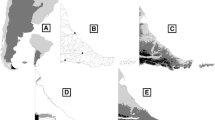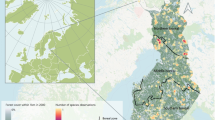Abstract
The main goal of Natura 2000 network is to guarantee the favourable conservation status of habitats and species ensuring European biodiversity. As a result, certain forest areas have been included in this network listed as 9230-Quercus pyrenaica habitat and 9340-Quercus ilex subsp. rotundifolia forest habitat. These areas were previously used for firewood extraction or livestock grazing and browsing. Nowadays these habitats are coppice forests with asexual regeneration, which is far from the desired conservation status. Traditional timber harvesting plans do not take account of the new objectives required for these Natura sites, which attempt to ensure biodiversity and recreational uses instead of simply focusing on timber production. This paper proposes a flexible methodology (applied to the study area “Dehesa Boyal” in Ávila, Spain) for managing Natura 2000 forest sites by stands for sustainable forest management and the new requirements. The methodology has two phases. The first, “Division of the forest area into stands”, defines homogeneous patches of vegetation distinct in species composition, physiognomic structure and future management. The second, “Conservation status assessment of stands”, quantifies the conservation status of each previously classified stand considering a series of factors such as: functional health, restoration, floral richness and structure. A total value integrating the conservation status of stands is then calculated for the habitat. Both phases use Geographic Information System tools for managing information and visualizing results. The proposed methodology provides forest managers with a good knowledge of the territory and subsequently enables them to take appropriate conservation measures to maintain biodiversity.




Similar content being viewed by others
References
Andersson FO, Feger KH, Huttl RF et al (2000) Forest ecosystem research—priorities for Europe. For Ecol Manag 132(1):111–119
Barbour MG, Sanchez-Mata D, Rodriguez-Rojo P et al (2007) Age structure of young- and old-growth Quercus pyrenaica stands in Spain. Phytocoenologia 37(3–4):583–598
Barbour MG, Barnhart S, Ugurlu E et al. (2008) Species characteristics and stand structure of Quercus garryana and Q. pyrenaica wooodlands in the Mediterranean region of California and Spain. In: Merenlender A, McCreary D, Purcell KL (eds) Proceedings of sixth symposium on oak woodlands: today’s challenges, tomorrow’s opportunities Gen Tech Rep PSW-GTR-217. U.S. Department of Agriculture, Forest Service, Pacific Southwest Research Station, Albany, CA, p 473
Bartolomé C (2005) Los tipos de hábitat de interés comunitario en España: guía básica. Dirección General para la Biodiversidad. Ministerio de Medio Ambiente, Madrid
Bissonette JA, Storch I (2003) Landscape ecology and resource management: linking theory with practice. Island Press, London
Boteva D, Griffiths G, Dimopoulos P (2004) Evaluation and mapping of the conservation significance of habitats using GIS: an example from Crete, Greece. J Nat Conserv 12(4):237–250
Brunson MW, Huntsinger L (2008) Ranching as a conservation strategy: can old ranchers save the new west? Rangeland Ecol Manag 61(2):137–147
Buchanan GM, Butchart SHM, Dutson G et al (2008) Using remote sensing to inform conservation status assessment: estimates of recent deforestation rates on New Britain and the impacts upon endemic birds. Biol Conserv 141(1):56–66
Cantarello E, Newton AC (2008) Identifying cost-effective indicators to assess the conservation status of forested habitats in Natura 2000 sites. For Ecol Manag 256:815–826
Davis LS, Jonhson KN (1987) Forest management. McGraw-Hill, New York
de Warnaffe GD, Devillez F (2002) Quantifying the ecological value of forests in order to integrate nature conservation in management planning: a multicriteria method. Ann For Sci 59(4):369–387
Forster M, Frick A, Walentowski H et al (2007) Approaches to utilising QuickBird data for the monitoring of NATURA 2000 habitats. In: International conference on monitoring the effectiveness of nature conservation, Birmensdorf, Switzerland, 3–6 Sep 2007, pp 155–168
Gavilan R, Fernandez-Gonzalez F (1997) Climatic discrimination of Mediterranean broad-leaved sclerophyllous and deciduous forests in central Spain. J Veg Sci 8(3):377–386
Gavilan RG, Fernandez-Gonzalez F, Blasi C (1998) Climatic classification and ordination of the Spanish Sistema Central: relationships with potential vegetation. Plant Ecol 139(1):1–11
González JM, Piqué MN, Vericat PG (2006) Manual de ordenación por rodales: gestión multifuncional de los espacios forestales. Centre Tecnológic Forestal de Catalunya
Graziano R, Gilberto P, Alessandro F (2009) A rapid and cost-effective tool for managing habitats of the European Natura 2000 network: a case study in the Italian Alps. Biodivers Conserv 18(5):1375–1388
Hazell P, Gustafsson L (1999) Retention of trees at final harvest—evaluation of a conservation technique using epiphytic bryophyte and lichen transplants. Biol Conserv 90(2):133–142
Huntsinger L (1996) Grazing in a California silvopastoral system: Effects of defoliation season, intensity, and frequency on deerbrush, Ceanothus integerrimus Hook & Arn. Agrofor Syst 34(1):67–82
Huxel GR, Hastings A (1999) Habitat loss, fragmentation, and restoration. Restor Ecol 7(3):309–315
Irvine RJ, Fiorini S, Yearley S et al (2009) Can managers inform models? Integrating local knowledge into models of red deer habitat use. J of Appl Ecol 46(2):344–352
Langanke T, Burnett C, Lang S (2007) Assessing the mire conservation status of a raised bog site in Salzburg using object-based monitoring and structural analysis. Landsc Urban Plan 79(2):160–169
Li CZ, Kuuluvainen J, Pouta E et al (2004) Using choice experiments to value the Natura 2000 nature conservation programs in Finland. Environ Resour Econ 29(3):361–374
Mace GM, Baillie JEM (2007) The 2010 biodiversity indicators: challenges for science and policy. Conserv Biol 21(6):1406–1413
Maggi M, Cerruti M, Estreguil C (2005) Implementing indicators for forest monitoring within alpine Natura 2000 sites. Monitoring and indicators of forest biodiversity in Europe—from ideas to operationality. In: EFI proceedings, vol 51, pp 333–342
Maiorano L, Falcucci A, Garton EO et al (2007) Contribution of the natura 2000 network to biodiversity conservation in Italy. Conserv Biology 21:1433–1444
Martinez JE, Pagan I, Palazon JA et al (2007) Habitat use of booted eagles (Hieraaetus pennatus) in a special protection area: implications for conservation. Biodivers Conserv 16(12):3481–3488
Montes F, Canellas I, del Rio M et al (2004) The effects of thinning on the structural diversity of coppice forests. Ann For Sci 61(8):771–779
Montoya JM (1982) Selvicultura, Ordenación y economía de los rebollares de Quercus pyrenaica Willd. Boletín de la estación central de ecología 11(22):3–13
Ostermann OP (1998) The need for management of nature conservation sites designated under Natura 2000. J Appl Ecol 35(6):968–973
Pelissier R, Goreaud F (2001) A practical approach to the study of spatial structure in simple cases of heterogeneous vegetation. J Veg Sci 12(1):99–108
Pringle RM, Syfert M, Webb JK et al (2009) Quantifying historical changes in habitat availability for endangered species: use of pixel- and object-based remote sensing. J App Ecol 46(3):544–553
San Miguel A (1985) Variaciones producidas en un pastizal arbolado con rebollos (Quercus pyrenaica Willd.) por claras de distinta intensidad. Diseño, intensidad y muestreo. An INIA Serv Forestal 9:97–104
Serrada-Hierro R, González I, Lopez C et al (1994) Dasometric classification and alternative silvopastoral uses of rebollo oak (Quercus pyrenaica Willd.) stands in Madrid. Investigación Agraria Sistemas Recursos Forestales Fuera de serie, pp 379–388
Smelko S, Fabrika M (2007) Evaluation of qualitative attributes of forest ecosystems by means of numerical quantifiers. J For Sci (Prague) 53(12):529–537
Szaro RC, Johston DW (1996) Biodiversity in managed landscapes, theory and practice. Oxford University Press, New York
Tejera-Gimeno R and Núñez-Martí MV (2007) Proyecto de ordenación del monte “Dehesa Boyal” nº 83 del C.U.P de la provincia de Ávila, en el término municipal de San Bartolomé de Pinares. Grupo de Investigación sobre Tecnologías y Métodos para la Gestión Sostenible (UPM). E.T.S.I.de Montes, Madrid
Valbuena-Carabana M, Gonzalez-Martinez SC, Gil L (2008) Coppice forests and genetic diversity: a case study in Quercus pyrenaica Wild, from Central Spain. For Ecol Manage 254(2):225–232
Varela RAD, Rego PR, Iglesias SC et al (2008) Automatic habitat classification methods based on satellite images: a practical assessment in the NW Iberia coastal mountains. Environ Monit Assess 144(1–3):229–250
Velázquez-Saornil J (2008) Propuesta metodológica para la ordenación integral de montes de la Red Natura 2000. Proyectos y Planificación rural. E.T.S.I.Montes, U.P.M, Madrid
Weber N, Christophersen T (2002) The influence of non-governmental organisations on the creation of Natura 2000 during the European Policy process. For Policy Econ 4(1):1–12
Zipkin EF, Dewan A, Royle JA (2009) Impacts of forest fragmentation on species richness: a hierarchical approach to community modelling. J Appl Ecol 46(4):815–822
Acknowledgments
This study was funded by Junta de Castilla y León for the implementation of forest management plans in Natura 2000 sites, and we thank the Junta for its general support. We wish to thank all of the members of “Research Group for Sustainable Management” for their support and comments. We extend special thanks to Antonio García Abril for his cooperation and assistance.
Author information
Authors and Affiliations
Corresponding author
Rights and permissions
About this article
Cite this article
Hernando, A., Tejera, R., Velázquez, J. et al. Quantitatively defining the conservation status of Natura 2000 forest habitats and improving management options for enhancing biodiversity. Biodivers Conserv 19, 2221–2233 (2010). https://doi.org/10.1007/s10531-010-9835-8
Received:
Accepted:
Published:
Issue Date:
DOI: https://doi.org/10.1007/s10531-010-9835-8




